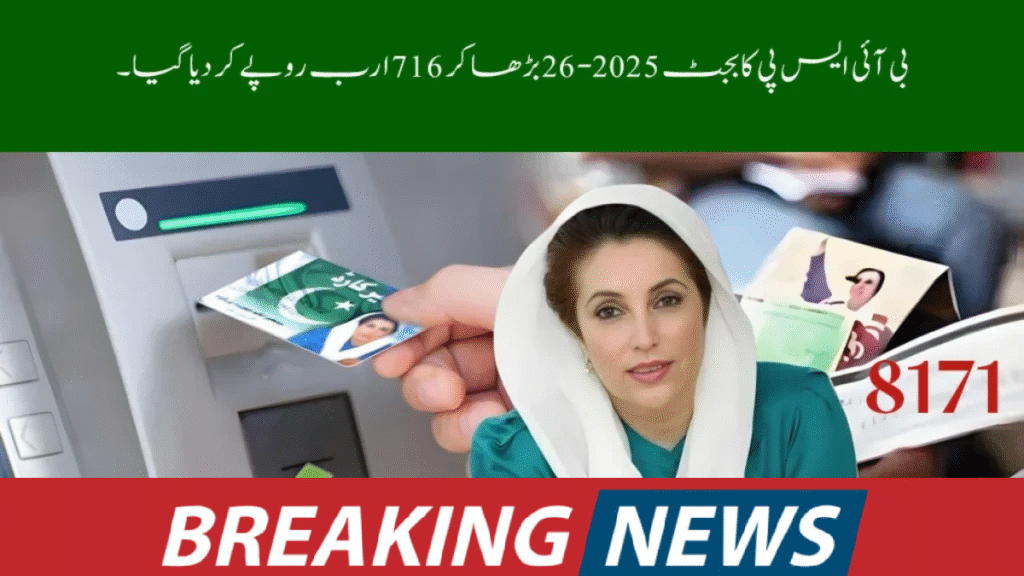
Every year, the federal budget is a roadmap for Pakistan’s economic priorities, and the fiscal year 2025-26 is no different. Among the various allocations, the significant hike in the Benazir Income Support Programme (BISP) budget to Rs. 716 billion stands out. This increase is not just a number—it’s a lifeline for millions of families relying on unconditional cash transfers and other social welfare initiatives. Coupled with the ongoing 8171 Ehsaas Program, these efforts aim to alleviate poverty and improve living standards across the country.
What is the BISP Budget 2025–26 Raised to Rs. 716 Billion?
The Benazir Income Support Programme (BISP) is Pakistan’s flagship social safety net initiative, primarily focused on providing unconditional cash transfers to low-income families. For the fiscal year 2025-26, the government has allocated Rs. 716 billion to BISP, marking a 21% increase compared to the previous year’s budget. This substantial rise reflects the government’s strategy to enhance social protection amid inflationary pressures and economic challenges.
Key Features of the Increased Budget
- Higher Cash Transfers: Quarterly payments under BISP are set to increase from Rs. 13,500 to Rs. 14,500 starting January 2026, helping beneficiaries keep pace with inflation.
- Sustaining Enrollment: The budget supports the enrollment of approximately 10 million households, ensuring no one is left behind.
- Inflation Adjustment: The government has committed to annual inflation adjustments for the Unconditional Cash Transfer (UCT) benefits, maintaining the real value of support.
- Collaboration with International Partners: BISP is working with the World Bank to enhance conditional cash transfer programs in education, health, and nutrition.
- Strengthening Electronic Payments: Plans are underway to expand BISP’s electronic payment system, enabling beneficiaries to access bank accounts and save money more efficiently.
The Role of the 8171 Ehsaas Program in Social Welfare
The 8171 Ehsaas Program is a complementary initiative working alongside BISP to deliver targeted social assistance. It leverages technology and data to identify eligible beneficiaries and streamline cash transfers, reducing leakages and improving transparency. This program is vital for ensuring that social safety nets reach those who need them most.
How the 8171 Ehsaas Program Enhances BISP
- Efficient Beneficiary Identification: Using digital tools, the program accurately targets vulnerable groups.
- Conditional Cash Transfers: Supports education, health, and nutrition by linking cash transfers to specific outcomes.
- Coordination with Provincial Authorities: Prevents overlap between federal and provincial welfare schemes.
- Pilot Projects for Financial Inclusion: Expands access to banking services for low-income families.
Why the Budget Increase Matters
The BISP Budget 2025–26 Raised to Rs. 716 Billion is more than just a financial figure—it’s a strategic move to reduce poverty and promote social equity. Here’s why this budget increase is crucial:
- Countering Inflation: With inflation expected to hover around 7.5%, the increased cash transfers help families maintain purchasing power.
- Reducing Poverty: Sustaining and expanding cash transfers directly impacts poverty reduction efforts.
- Supporting Vulnerable Populations: Women, children, and marginalized communities benefit from improved social safety nets.
- Stimulating Economic Growth: Cash transfers boost consumption, which in turn supports local businesses and economic activity.
Breakdown of BISP Budget Allocation
To better understand how the Rs. 716 billion will be utilized, here’s a simplified breakdown:
- Unconditional Cash Transfers (UCT): Largest share to support basic needs.
- Conditional Cash Transfers (CCT): Focused on education, health, and nutrition.
- Program Administration: Costs related to running and expanding the program.
- Technology and Infrastructure: Investments in electronic payment systems and data management.
Government’s Broader Social Protection Strategy
The BISP budget increase fits into a wider government agenda that includes:
- Energy Subsidy Reforms: Targeting subsidies to the bottom 40% to reduce fiscal pressure while protecting the poor.
- Public Sector Reforms: Streamlining ministries and departments to improve efficiency.
- Collaboration with International Agencies: Partnering with the World Bank and others to enhance program effectiveness.
Benefits for the Common Citizen
If you or someone you know is a beneficiary of the BISP or 8171 Ehsaas Program, here’s what to expect:
- Higher cash payments helping with rising costs.
- More streamlined and transparent payment processes.
- Expanded access to financial services.
- Increased support for education and health through conditional programs.
Conclusion
The BISP Budget 2025–26 Raised to Rs. 716 Billion is a landmark decision reflecting Pakistan’s commitment to its most vulnerable citizens. By increasing cash transfers, adjusting for inflation, and integrating technology through the 8171 Ehsaas Program, the government is strengthening its social safety nets. This budget not only provides immediate relief but also lays the foundation for sustainable poverty reduction and social development.
FAQs
Q1: What is the significance of the BISP budget increase to Rs. 716 billion?
The increase ensures higher cash transfers, inflation adjustments, and the enrollment of more households, directly benefiting millions of vulnerable families.
Q2: How does the 8171 Ehsaas Program complement BISP?
It uses technology for better beneficiary targeting, supports conditional cash transfers, and helps coordinate social welfare efforts across federal and provincial levels.
Q3: Will the cash transfer amounts increase in 2025-26?
Yes, quarterly payments are set to rise from Rs. 13,500 to Rs. 14,500 starting January 2026 to help offset inflation.
Q4: How does the government plan to improve payment systems for beneficiaries?
BISP is expanding its electronic payment system, enabling beneficiaries to open bank accounts and save money more effectively.
Q5: What other social sectors benefit from the increased BISP budget?
Education, health, and nutrition sectors benefit through conditional cash transfer programs supported by BISP and the 8171 Ehsaas Program.
Q6: How does this budget align with Pakistan’s economic growth goals?
By supporting vulnerable populations and boosting consumption, the budget contributes to the targeted 4.2% economic growth in FY26.
This comprehensive boost in the BISP Budget 2025–26 Raised to Rs. 716 Billion alongside the robust 8171 Ehsaas Program is a promising step towards a more inclusive and resilient Pakistan.


